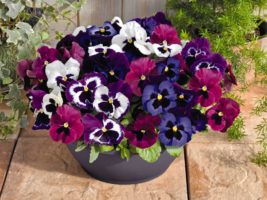Pansies have been in fashion since Victorians thought them to be the flowers of lovers, and have been a popular ingredient in “love potions”. It has been told that pansies could transfer the thoughts of sweethearts without a single word being spoken. Pansies have been present in the writings of many authors, including D. H. Lawrence, Hawthorne, Wordsworth, and Shakespeare.
Pansies remain one of our most popular spring flowers. They are carried home by gardeners to perk up otherwise dull spring landscapes. Pansies are desired for their early-spring color when it seems like the cold weather will never end.
Pansies are best used as annuals since they deteriorate in the heat of summer and should be planted in the cooler seasons of spring and fall. Plant them as cheery bright spots in spring gardens with the plan to replace them with heat tolerant plants for summer.
Pansies can also be planted in September and October to give us color until the blustery winter weather arrives. As soon as temperatures moderate in the spring, they spring back to life with even more vigor and bloom. They are tough little plants; perfectly suited to rock gardens and containers.
Pansies like sunny, moist conditions. They bloom best when there is ample water provided by rich soil in raised beds and container gardens. They are heavy feeders, so for maximum color and fragrance feed them twice a month with all purpose fertilizer. Deadheading promotes more flowers that will bloom for longer periods of time.
The best thing about pansies is the broad range of colors in which they come. These flowers always remind me of bright smiley faces, which brings amazing character to gardens and containers.


